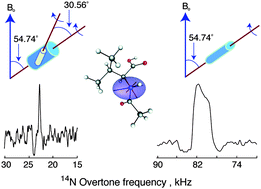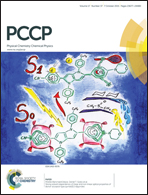14N overtone transition in double rotation solid-state NMR†
Abstract
Solid-state NMR transitions involving outer energy levels of the spin-1 14N nucleus are immune, to first order in perturbation theory, to the broadening caused by the nuclear quadrupole interaction. The corresponding overtone spectra, when acquired in conjunction with magic-angle sample spinning, result in lines, which are just a few kHz wide, permitting the direct detection of nitrogen compounds without the need for labeling. Despite the success of this technique, “overtone” resonances are still broadened due to indirect, second order effects arising from the large quadrupolar interaction. Here we demonstrate that another order of magnitude in spectral resolution may be gained by using double rotation. This brings the width of the 14N solid-state NMR lines much closer to the region commonly associated with high-resolution solid-state NMR spectroscopy of 15N and demonstrates the improvements in resolution that may be possible through the development of pulsed methodologies to suppress these second order effects.



 Please wait while we load your content...
Please wait while we load your content...